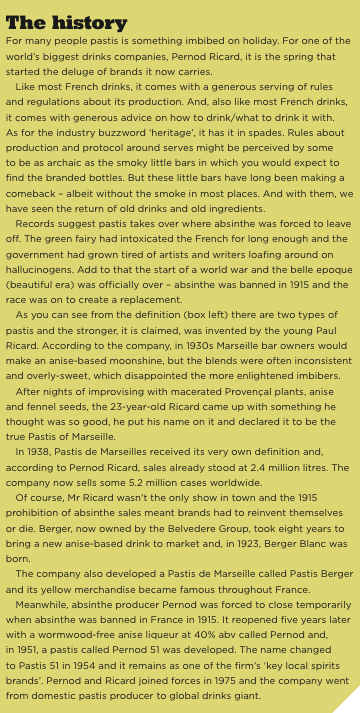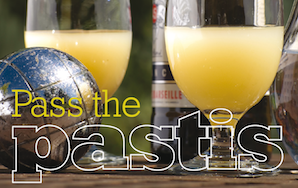Pastis remains a largely French tipple and its anise relatives in other parts of Europe – ouzo from Greece or raki from Turkey for example – don’t seem to travel well either. For anyone who has brought a bottle home from holiday, recreating the vacation experience in your own home is almost always disappointing and drinks rarely taste the same as they did when you were immersed in the culture of their creation.
Nevertheless, there is a market for pastis and there is also innovation. But for some, its stumbling block is the lack of romance and sense of movement that surrounded its green fairy godmother – absinthe. Cathy Cantone from the export sales department of Henri Bardouin pastis says that, apart from expatriates, consumers outside France “do not know about pastis”.
“The message carried by pastis does not cross the frontiers as well as the message of absinthe did,” she says. “Nowadays, there is a lack of cultural support for pastis – we are waiting for a new artist or any success stories which could help. Absinthe is well-known due to its big history. Consumers do not know that pastis was born after the ban of absinthe.” (See history below)
Natural herbs
Henri Bardouin is produced and distilled in the Pays de Forcalquier, an area of Provence famous for its natural herbs and officially classified as a “site remarquable du gout” (remarkable site of taste). At the beginning of the last century there were 10 distilleries in Forcalquier producing pastis. Now, Distilleries et Domaines de Provence, which produces Henri Bardouin pastis as well as Absente 55, among other brands, is the only distillery that remains in the area.
Despite the holiday feeling around the product, there is a growing demand for pastis outside of France. After its spiritual home, Belgium is the most important market for the Ricard brand – and, as you might expect, the category tends to do well primarily in French-speaking outposts.
Bardouin’s Cantone says her brand is exported to “several countries where French expatriates live‚” including the US, Canada and Switzerland.
In Belgium, Ricard has doubled its volume over the past 15 years and growth isn’t just coming from the French.
Caroline Casta, external communications manager for Pernod Ricard, adds: “Consumption of pastis was historically established in Wallonia, in the French-speaking part of Belgium, but now the growth of Ricard and of the pastis category comes from the Dutch-speaking part, which accounts for 40% of sales.”
Aurelie Lory, group marketing manager for Belvedere’s Marie Brizard, which owns the Berger pastis brand, says the overseas departments and territories of France are inhabited by pastis drinkers.
“All over the Mediterranean sea you have pastis variations such as ouzo and raki,” she adds.
“Otherwise pastis is really French.”
But Pernod Ricard’s sights are set further afield than France and Belgium – after all, it’s a multinational company these days. It describes Ricard as one of its ‘strategic premium spirits brands’ and the company has a brand ambassador for Ricard in New York.
Casta says the brand ambassador “develops the brand in bars and restaurants, relying on recipes that are very well appreciated by American consumers” – such as the Zanzibar (see right).
This approach is supported by the creation of events around Ricard such as Bastille Day in Brooklyn, which is said to gather thousands of people using Ricard as the symbol of the French Art de Vivre.
As you might expect, the company with the market-leading brand sees a rosy – and rosé – future for the category.
Casta at Pernod Ricard says it’s a green light all the way for pastis “and therefore for Ricard”. The Ricard brand celebrated its 80th anniversary last year, and according to Casta its market share in France is more than 40% – though the 2013 Millionaires’ Club suggests Ricard’s figures plummeted 11% between 2011 and 2012.

|
Ubdeterred, the company has developed a Twist’r promotion. The concept launched in 1,000 bars across France in December 2012 and it features a cap with a ball that rolls around the top to mix the ingredients of the drink – rather than a bartender shaking them.
But perhaps the company’s most successful serve for pastis is its Piscine concept in large balloon glasses, a bit like the Gin Tonica in Spain.
The company says it is this serve that changed the way consumers look at the drink and made way for innovation. And, like the other famous French category, Cognac, making a rosé is the innovation du jour.
In April 2013, Ricard launched a rosé version of its traditional anise-based 51.
The marketing material claims the drink “will appeal to pastis aficionados, while also seducing a younger and more feminine population thanks to notes of pink grapefruit, strawberry, blackcurrant and raspberry”.
The abv is lower than the original 51 – 35% instead of 45% – so neither Pastis nor Pastis de Marseille appears on the label.
“51 wishes to get things moving and bring a new experience to the market,” says Mathieu Deslandes, marketing director of Pernod. “We have been able to change the codes of pastis in the past four years thanks to our Piscine way of serving it, in a big balloon glass with a larger proportion of water and lots of ice.”
For Henri Bardouin, the marketing focus is on the terroir and the quality of the product. The company describes it as the genuine Grand Cru Pastis de Provence.”
On the export front, the brand made a national listing in UK supermarket Waitrose last month (April), priced £20.75. The suggested serve is traditional in comparison to Pernod Ricard’s efforts and the company says it should be served with one part pastis to five or six parts water.
“Henri Bardouin Pastis should be poured into the glass first and water added from a jug containing ice, chilled to 4°C. Please do not put ice in your drinking glass because this kills the wonderful aromas.
“Only as the water and the pastis blend do you see the distinctive colour and appreciate the full power of the complex recipe of herbs and spices,” adds Cantone.
Pastis in the kitchen
Cooking with pastis is also big news for Henri Bardouin. Cantone says it matches well with tuna, salmon and chicken dishes. But ultimately Cantone expresses frustration that the product is not more popular.
“Pastis HB should be more popular: This is not a strong alcoholic beverage once the water is poured in and it could suit more consumers. But, as I said before, a cultural linking is sorely missing for pastis.”
Now absinthe is legal again, it will be interesting to see how the two products interact in the future. Theirs is a history inextricably linked.




